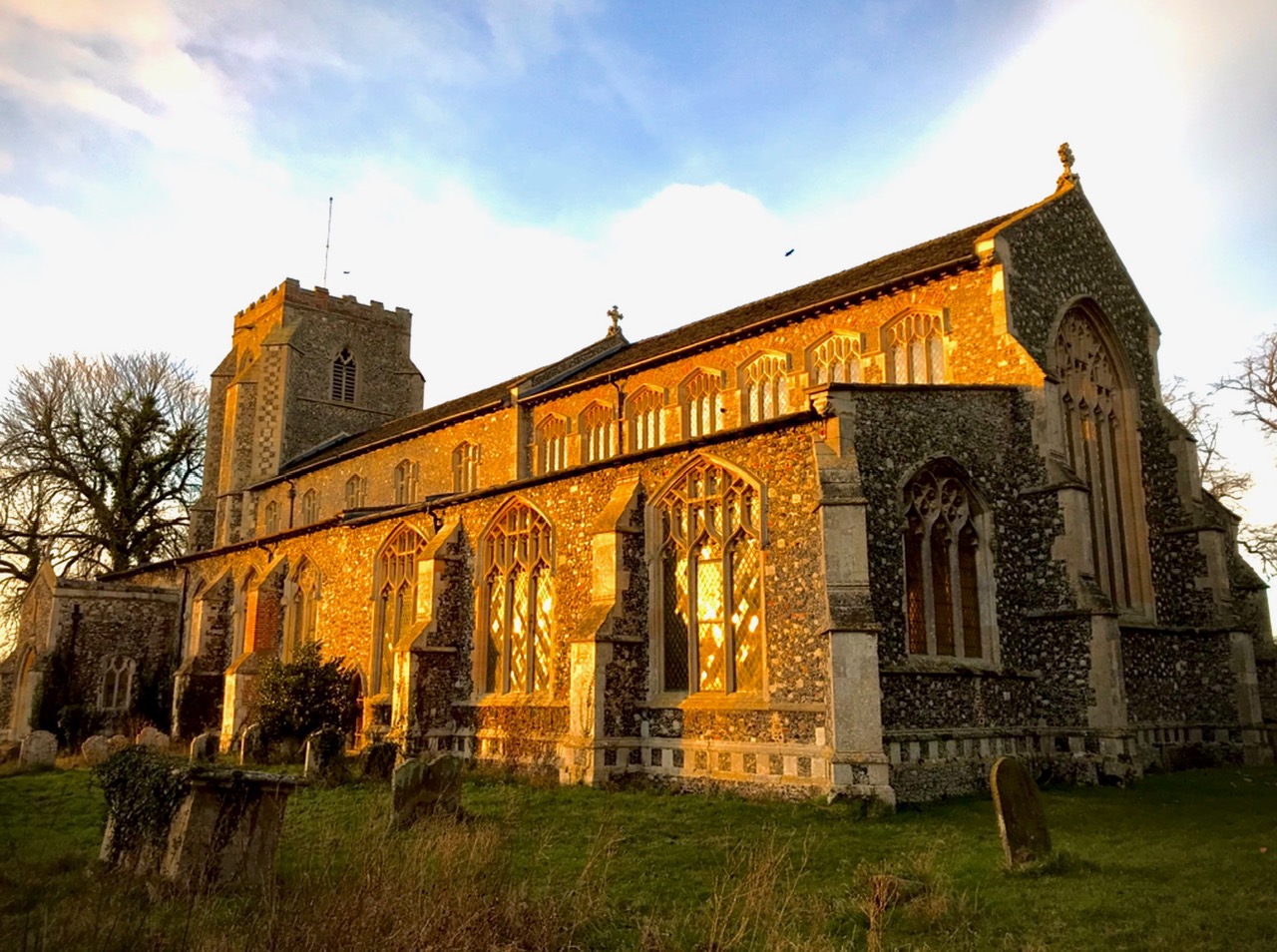
St Andrew’s Church, Wingfield, Suffolk. Mausoleum of the de la Poles.
You know when the great Sir Nikolaus Pevsner was ‘impressed’ with a church then it must indeed be rather special (1). And St Andrew’s with its soaring clerestories, nave roof with arched braces resting on figures of winged angels, charming ‘Decorated’ window tracery of flower petals and the rood loft reached by two stairways does not disappoint. Combine all that with some of the finest 15th century medieval monuments in England and it takes some beating.
Founded by Sir John Wingfield d.1361 improvements to the church was carried out by both his son in law Michael de la Pole First Earl of Suffolk d.1389 and in his turn by his son, Michael de la Pole, Second Earl of Suffolk d.1415. The improvements made by the second Earl are described by Pevsner as the ‘real glory‘ of the church and the monuments of the Earl and Katherine Stafford his wife lie today between the chancel and the chapel which he built.
Sir John Wingfield c. 1307- d. 1361.
Sir John’s monument lies in the north side of the chancel. Held in high esteem by Edward of Woodstock, Prince of Wales known as the Black Prince, who in 1356 appointed him Chief Administrator of the Prince of Wales and in October 1359 Master of the Household and Prince’s Councillor. The Black Prince would later pay £57 13 4d for his funeral (2). He left much of his wealth for the rebuilding of St. Andrew’s Church as well as the foundation of a chantry college and to make Wingfield a collegiate church. These wishes his widow, Eleanor/Alianore, would help to arrange. Sir John’s monument is much worn now but the etchings by Charles A Stothard in the early 19th century have captured what it once would have looked like.
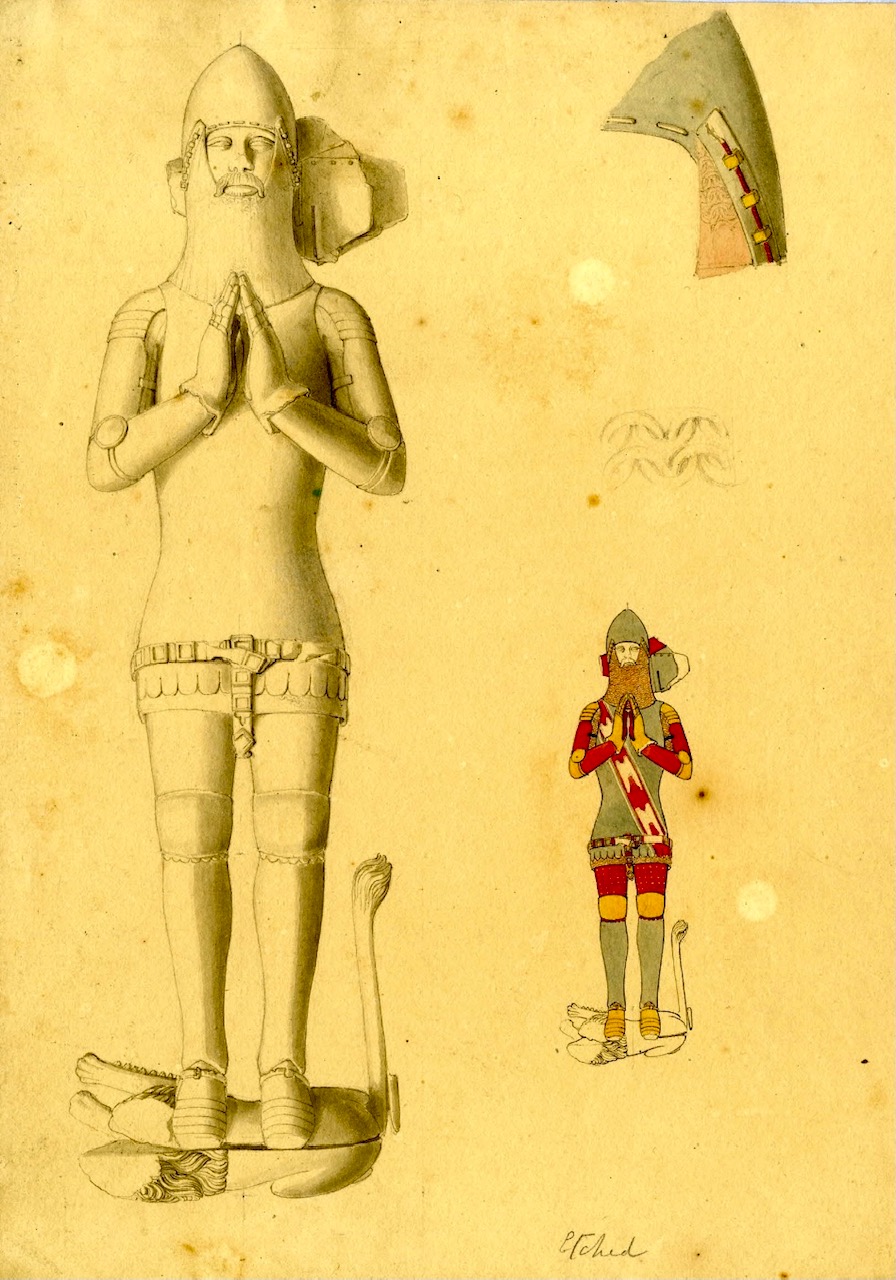
Sir John Wingfield’s effigy Wingfield Church. Etching by Charles A Stothard.
SIR MICHAEL de la POLE, FIRST EARL OF SUFFOLK c. 1330-1389
Although not buried at Wingfield, Sir Michael de la Pole’s story should be touched upon to better understand the link of the de la Poles to Wingfield. Sir Michael was the eldest son of Sir William de la Pole d. 1366, a financier, successful wool merchant and entrepreneur from Kingston upon Hull. In 1361, the year of her father’s death, the 30 year old Sir Michael married Sir John Wingfield’s 13 year old daughter and heiress, Katherine (b.c1349 d.1385). Her father’s death shortly before the marriage brought a ‘dowry of substantial estates‘ (3). Sir Michael also had links with Edward ‘the Black Prince’ and it may be that it was the Black Prince’s patronage helped with the Wingfield marriage. Sir Michael had come a long way. As historian Anthony Emery points out, the de la Poles story is a classic example of how a rapid rise in social advancement was possible from a wool merchant to an earldom in two generations to even a heir presumptive four generations later. In 1362 following his father in law’s death and under the terms of his will, Sir Michael and his young wife would establish the college of priests at Wingfield and rebuild much of the church ‘sumptuoso’. After a busy career with some ups and some downs, and which I do not have space to go into here, Sir Michael was convicted of treason by the Merciless Parliament in 1388. Being a favourite of Richard II had made him a scapegoat for the king’s enemies. Escaping to France he was out of reach of those who wanted him dead but was to die shortly after in Paris on the 5 September 1389. He would be brought home to England to be buried alongside his wife, who had died around the onset of his downfall in 1385, in the Carthusian Priory, Kingston upon Hull.
MICHAEL de la POLE, SECOND EARL OF SUFFOLK c.1367-d.1415
It is Michael de la Pole, second Earl of Suffolk, who lies at rest in Wingfield Church along with his wife, Katherine Stafford, for after his father’s death he regained possession of the entailed land of his family which had only been confiscated during Sir Michael Snr’s lifetime. Thus he was able to return home to Wingfield. He completed his father’s unfinished building works including the enlargening and beautifying of Wingfield Church. He and his wife made their home at Wingfield, building Wingfield castle and gaining a licence to crenellate in 1384. He lived out a respectable life, managing to avoid the many pitfalls of the times that had resulted in his father’s fall and earned the accolade of being a ‘knight of excellent and most gracious name. By his studied respectability he sucessfully removed from his family’s reputation the taint of scandal that had hitherto hung about it (4). Sir Michael would travel to France to serve Henry V in 1415 taking with him a force of 40 men at arms and 120 mounted archers. Sadly on the 17th September he succumbed to dysentery at the siege of Harfleur. He had requested in his will to be buried at Wingfield in the church that he had added to and enhanced. This requested was carried out and to this day he rests there with his wife Katherine Stafford.

Michael de la Pole and his wife Katherine Stafford. Effigy in St Andrew’s church, Wingfield.
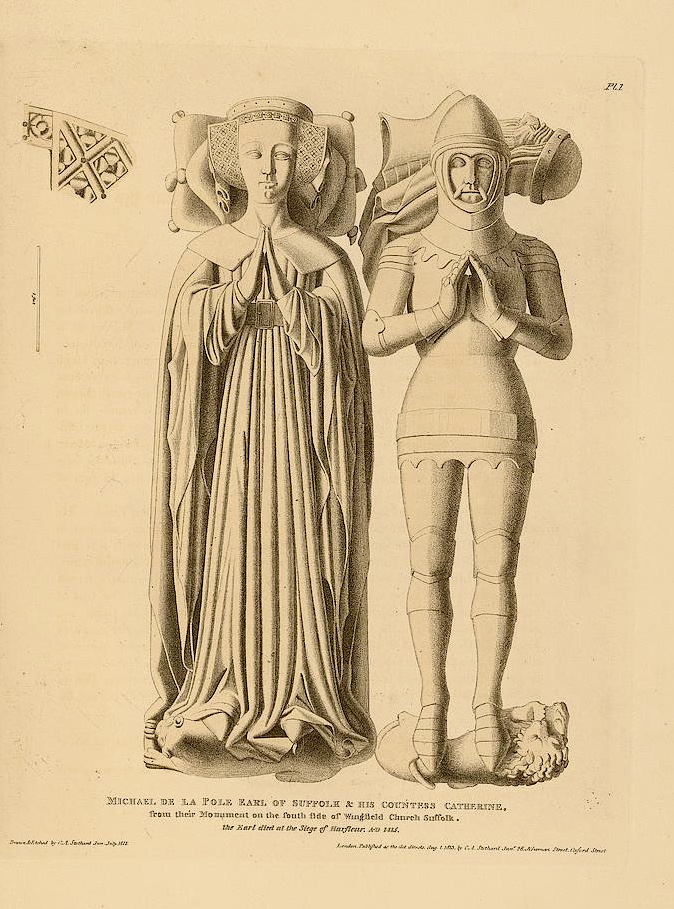
Michael de la Pole, 2nd Earl of Suffolk and Katherine Stafford. An etching by C A Stothard.
JOHN de la POLE, SECOND DUKE OF SUFFOLK AND ELIZABETH PLANTAGENET
Also resting here with a wonderful tomb, the gem of Wingfield, are John de la Pole, Duke of Suffolk b.1442 d.1492 and his wife Elizabeth Plantagenet, sister to Edward IV and Richard III. John was Michael de la Pole’s grandson. His father William de la Pole’s story can be found elsewhere. It is tragic and it would appear that John de la Pole perhaps learning from his father’s fate and with some degree of luck avoided the dangerous events of 1485 which culminated in the final and total ruin of his wife’s family as well as the rebellion led by his son John de la Pole, Earl of Lincoln which resulted in Lincoln’s death at Stoke Field in 1487. As Michael Hicks wrote ‘He was a loyal member of the Yorkist house and shared in several of its victories that were far from predetermined for success. Luck, rather than studied calculation, explains his escape from the consequences of any major defeats and disasters. He avoided supporting causes that were lost, quickly acquiescing in the successions of Richard III and Henry VII’ (5). The face on the effigy, perhaps based on a death mask has been described as careworn. No doubt, no doubt…. although dying in 1492 he was spared the violent deaths of his other sons Richard and Edmund.
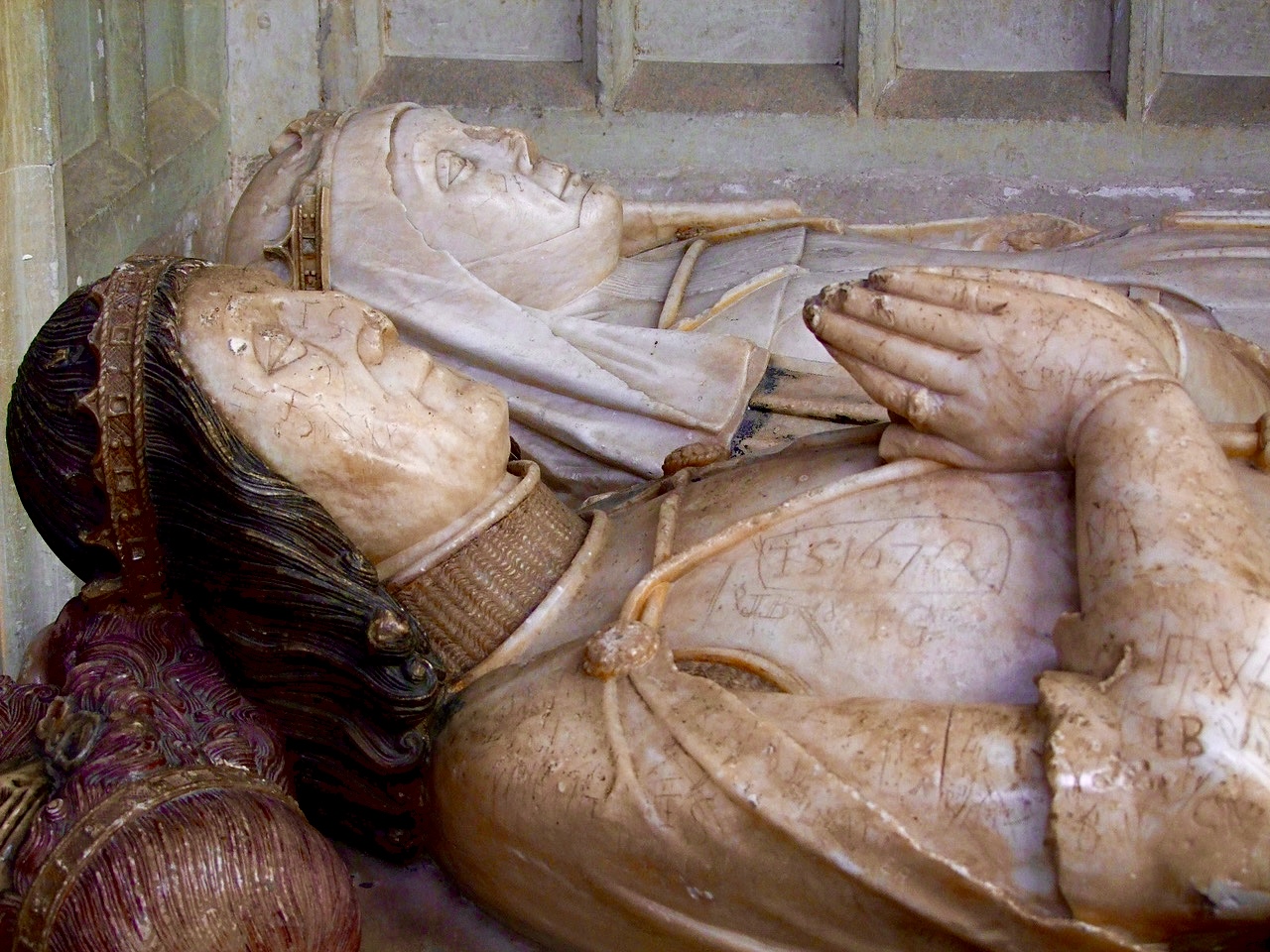
John de la Pole, second Duke of Suffolk and his wife Elizabeth Plantagenet. Alabaster effigies Wingfield Church
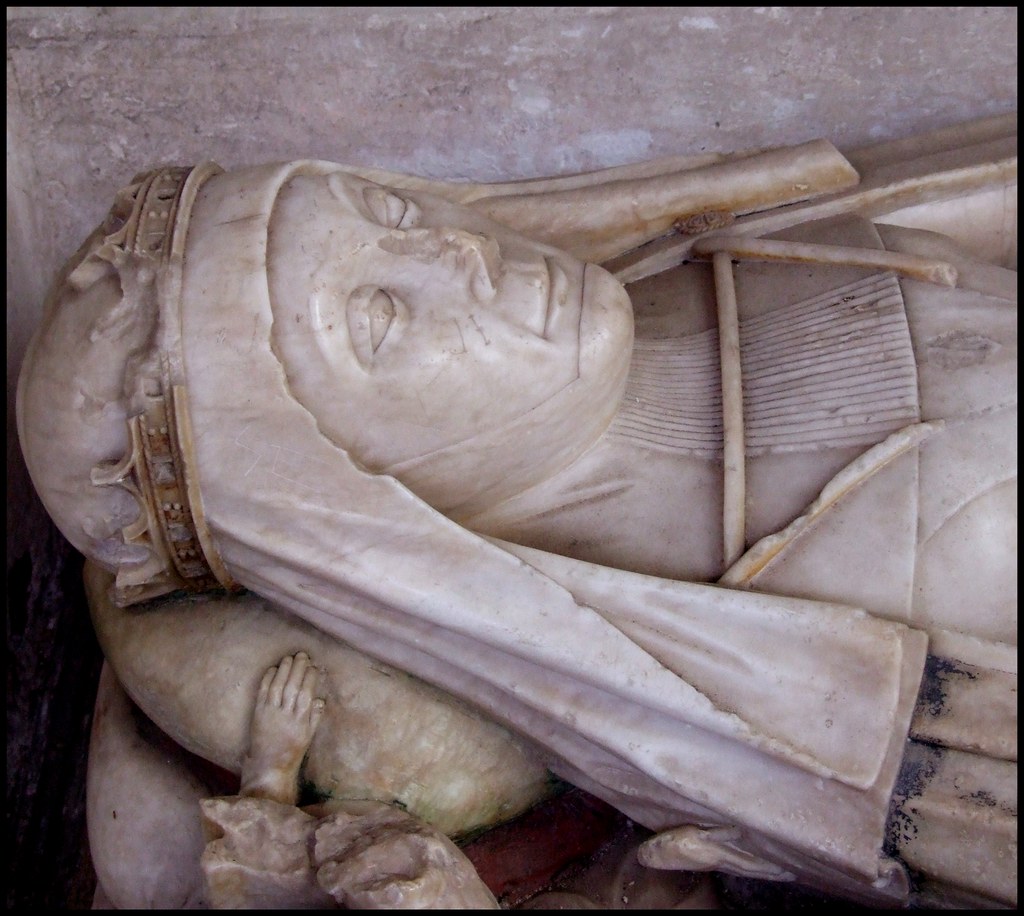
Elizabeth Plantagenet – sister to kings. Dying in 1503 and depicted here in her widow’s ‘barbe’.

John de la Pole, second Duke of Suffolk. Alabaster effigy Wingfield Church.

The merry little lion at the feet of John de la Pole gazes around at him in perpetuity.. Photo Simon Knott @ Flickr
At the end of the day the de la Poles that chose Wingfield as their burial place were more fortunate than the other family members who opted for the Carthusian Priory of Kingston upon Hull. For their remains were lost when the priory was dissolved 1539 and later demolished. The bones mentioned by Leyland in his Itiniary ‘dyverse trowehes of Leade with bones in a Volte under the high Altare ther….. ‘ were probably the remains of the de la Poles that were discovered sadly only to be lost forever.
1. The Buildings of England : SUFFOLK p.490. 2nd Edition revised by Enid Radcliffe.
2. Wingfield Family Society Online Website
3. Greater Medieval Houses of England and Wales VoI II. p.160. Anthony Emery.
4. Pole, Michael de la, 2nd Earl of Suffolk. 1367-1415. Simon Walker. Oxford Dictionary of National Biography.
5. Pole, John de la, Second Duke of Suffolk (1442-1492). Michael Hicks. Oxford Dictionary of National Biography 17 September 2015.
If you enjoyed this post you might also like:
AVELINE de FORZ – AN EARLY PLANTAGENET BRIDE – HER TOMB IN WESTMINSTER ABBEY
CARDINAL JOHN MORTON’S TOMB IN THE CHAPEL OF LADY UNDERCROFT CANTERBURY CATHEDRAL
MINSTER LOVELL HALL, HOME TO FRANCIS LOVELL VISCOUNT LOVELL
ANNE MORTIMER AND RICHARD OF CONISBURGH , A LOVE MATCH?
5 thoughts on “St Andrew’s Church, Wingfield and the Tombs of the de la Poles”